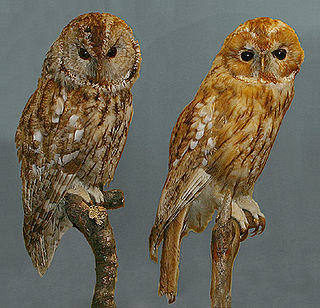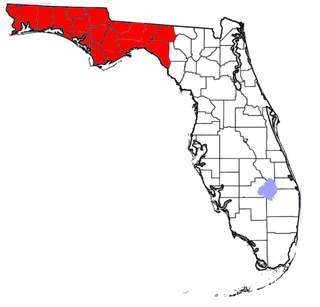
OclemenaE.L.Greene, is a small genus of North American flowering plants in the aster tribe within the.
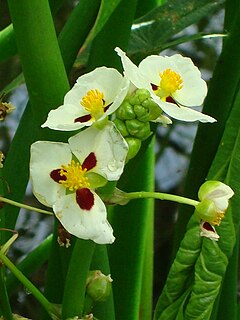
Sagittaria montevidensis is a species of flowering plant in the water-plantain family Alismataceae. Common names include giant arrowhead and California arrowhead.

Ionactis linariifolia also known as the flax-leaf ankle-aster, flaxleaf whitetop or simply aster is a North American species of plants in the daisy family.

Solidago nemoralis is a species of flowering plant in the aster family, Asteraceae. It is native to North America, where it is widely found in Canada and the United States. Its common names include gray goldenrod, gray-stem goldenrod, old-field goldenrod, field goldenrod, prairie goldenrod, dwarf goldenrod, and dyersweed goldenrod.

Doellingeria is a genus of flowering plants in the aster family. It contains species formerly included in Aster but now considered to be a distinct genus. They are known commonly as tall flat-topped asters or whitetops.

Sagittaria cuneata is a species of flowering plant in the water plantain family known by the common name arumleaf arrowhead or duck potato. Like some other Sagittaria species, it may be called wapato. It is native to much of North America, including most of Canada as well as the western and northeastern United States.
Sagittaria longiloba is a species of flowering plant in the water plantain family known by the common name longbarb arrowhead and Gregg arrowhead. It is native to the south-central and southwestern United States plus Mexico, Venezuela and Nicaragua. It is also reportedly naturalized in the western Himalayas of India and Bhutan. It grows in slow-moving, stagnant, and ephemeral water bodies such as ponds and small streams, and sometimes disturbed and cultivated habitat such as rice fields and irrigation ditches.

Deinandra fasciculata, known by the common names clustered tarweed and fascicled spikeweed, is a species of flowering plant in the daisy family native to western North America.

Symphyotrichum prenanthoides is a species of flowering plant in the aster family known by the common name crookedstem aster. It is native to eastern North America, where it occurs in eastern Canada and the eastern United States.

Sericocarpus linifolius is a perennial forb native to the eastern United States, that produces white composite flowers in summer.

Cardamine angustata is a perennial forb native to the eastern United States, that produces white to pink or purple flowers in early spring.

Cardamine douglassii is a perennial forb native to the eastern and central United States as well as the province of Ontario in Canada, that produces white to pink or purple flowers in early spring.
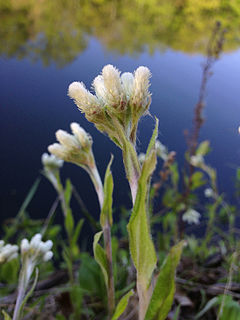
Antennaria plantaginifolia is a perennial forb native to the eastern North America, that produces cream colored composite flowers in spring.

Clitoria mariana, is a perennial forb.

Helianthus decapetalus, known by the common names thinleaf sunflower and thin-leaved sunflower, is a perennial forb in the sunflower family. It is native to the Eastern and Central United States and Canada, from New Brunswick west to Iowa, Wisconsin, and Ontario, south as far as Georgia and Louisiana. It produces yellow composite flowers in late summer or early fall.

Penthorum sedoides, known by the common name ditch stonecrop, is a perennial forb native to the eastern United States and Canada which produces small white flowers in summer.

Sagittaria teres, the quill-leaved arrowhead or slender arrowhead, is an aquatic plant species of arrowhead native to the northeastern United States: Rhode Island, Massachusetts, New Hampshire, New York and New Jersey.
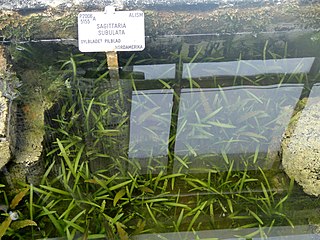
Sagittaria subulata, the awl-leaf arrowhead, narrow-leaved arrowhead or dwarf sagittaria, is an aquatic plant species that grows primarily in shallow brackish water along the seacoast, in marshes, estuaries, etc. It is native to the Republic of Colombia, the District of Columbia, Venezuela, and every US state along the coast from Massachusetts to Louisiana. It has also been reported as naturalized in Great Britain on just three occasions; only one of these is recent and here it appears to have become extinct by 2010. It is also recorded as a non-native on the Azores, and on the Island of Java in Indonesia.

Doellingeria umbellata, known by the common names tall flat-topped white aster, parasol whitetop, or tall white-aster, is a North American plant species in the aster family. It is native to Canada, St. Pierre and Miquelon, and the eastern and north-central United States (from Nebraska and the Dakotas east to Maine and South to Mississippi, Georgia and the Florida Panhandle.
Doellingeria sericocarpoides is a North American perennial forb native to the eastern United States. It ranges from eastern Texas and southeastern Oklahoma to northern Florida north as far as New York State, though uncommon in the northern part of that range.




